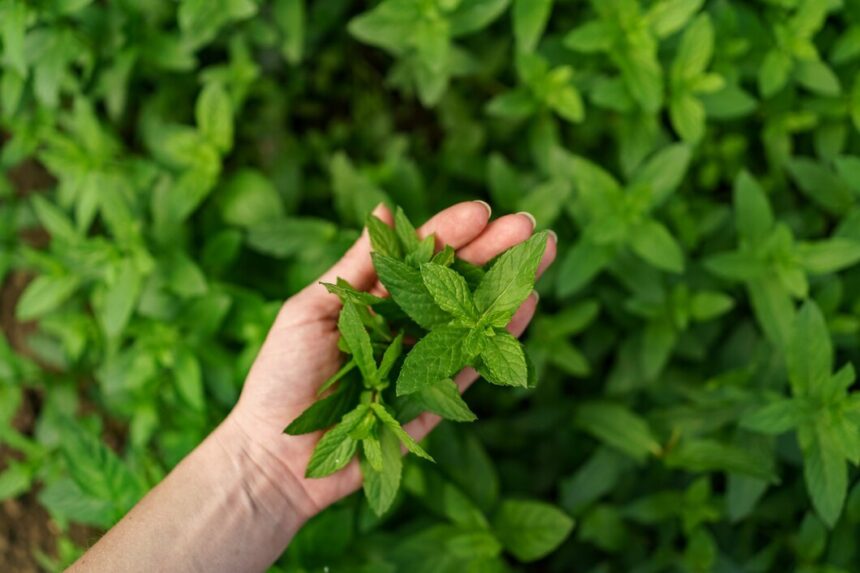Mint is a popular herb for South African farmers, prized for its versatility in culinary, medicinal, and cosmetic applications. Growing mint from seed to harvest requires careful planning, understanding of the growth stages, and knowledge of inputs, machinery, and practices for a successful crop. Here’s a step-by-step guide on how to cultivate, care for, and harvest mint in South Africa.
1. Soil Preparation and Land Preparation
- Soil Type: Mint thrives in loamy, well-drained soils with a pH between 6.0 and 7.5. South African farmers should ensure the soil is rich in organic matter to support the high nutrient demands of mint.
- Land Preparation: Mint roots spread widely, so loosen the soil to a depth of at least 30 cm. Remove weeds and add organic compost or manure to enrich the soil. Prepare raised beds if the area has poor drainage, as mint is susceptible to root rot in waterlogged conditions.
- Machinery: Depending on the farm size, a tiller or plough can be used to prepare the land and incorporate organic amendments.
2. Planting Mint Seeds
- Seed Preparation: Mint seeds are small and require careful handling. Soak them in warm water overnight to improve germination rates.
- Planting: Sow seeds directly into the prepared soil or start them in seed trays. Place seeds on the soil surface and lightly cover them with a thin layer of soil. Seedlings generally emerge within 7–14 days.
- Spacing: Maintain a spacing of about 20–30 cm between plants, as mint spreads quickly and needs room for airflow to prevent fungal infections.
3. Growth Stages and Care Requirements
Germination (1–2 weeks)
- Conditions: Mint seeds germinate best in warm temperatures between 20–25°C.
- Watering: Keep the soil consistently moist but not waterlogged.
- Fertilizer: Apply a balanced starter fertilizer (N-P-K: 10-10-10) at planting time to support seedling development.
Vegetative Growth (3–8 weeks)
- Watering: Mint requires consistent moisture but should not be waterlogged. Provide 2–3 cm of water weekly, more frequently in hot or dry conditions.
- Fertilizers: Apply nitrogen-rich fertilizer every 3–4 weeks to encourage lush leaf growth. Organic options like compost tea or diluted fish emulsion work well.
- Weed Control: Manual weeding or mulching helps to suppress weeds without using herbicides, which can damage delicate mint roots.
- Disease Monitoring: Common diseases include powdery mildew and rust. Ensure good airflow by spacing plants correctly and pruning overcrowded areas. Inspect for signs like white powder on leaves (powdery mildew) and yellow spots (rust).
Mature Plant Care (8 weeks and beyond)
- Pruning: Regular pruning encourages branching and more leaf production. Trim about a third of the plant every 4–6 weeks.
- Water and Nutrients: Maintain consistent watering and apply a balanced fertilizer once a month.
- Pest Control: Aphids, spider mites, and mint leaf beetles are common pests. Natural insecticides like neem oil are effective if infestations occur, but avoid synthetic pesticides if possible to preserve the mint’s aromatic qualities.
4. Pest and Disease Management
- Common Pests: Aphids, spider mites, and leaf miners are common pests for mint. Use insecticidal soap or neem oil sprays if necessary, applying in the early morning or evening to avoid leaf burn.
- Diseases: Mint is prone to fungal diseases, including powdery mildew, rust, and root rot. Prevent fungal infections by maintaining proper spacing, removing infected leaves, and avoiding overhead watering.
- Herbicide Use: Herbicides are typically not recommended for mint, as they can harm the plant’s roots and sensitive foliage. Instead, focus on mulching and manual weed removal.
5. Irrigation Requirements
- Amount of Water: Mint is a moisture-loving herb, requiring about 2–3 cm of water per week. Increase watering during hot, dry weather.
- Irrigation Frequency: Water mint every 2–3 days, ensuring the soil stays moist without becoming soggy.
- Irrigation Systems: Drip irrigation is ideal, as it delivers water directly to the root zone, minimizing fungal risks associated with overhead watering.
6. Fertilizers and Soil Amendments
- Initial Fertilization: At planting, apply a balanced fertilizer or organic compost to enrich the soil.
- Nitrogen Application: Mint benefits from nitrogen-rich fertilizers, applied monthly to promote lush foliage. Organic options like composted manure or fish emulsion are effective and sustainable.
- Supplemental Fertilization: A foliar spray with seaweed extract or liquid kelp once a month can improve growth and pest resistance.
7. Harvesting Mint
- Timing: Mint can be harvested about 60–90 days after planting, once plants reach about 15–20 cm in height.
- Harvesting Technique: Use sharp scissors or pruning shears to cut sprigs, leaving at least 1/3 of the plant intact to allow for regrowth. Harvest in the morning for the highest oil content, which enhances aroma and flavor.
- Frequency: Regular harvesting every 2–4 weeks encourages bushier growth and a more productive plant.
8. Storage and Preservation
- Drying: Dry mint by hanging bunches upside down in a warm, dark, and well-ventilated area. Once dry, crumble the leaves and store them in an airtight container away from light and moisture.
- Freezing: Fresh mint can be frozen by chopping the leaves and storing them in ice cube trays filled with water. This method preserves flavor for longer.
- Storage Conditions: Store dried mint in cool, dark places, while frozen mint should be kept in a freezer at a constant temperature.
Summary of Machinery and Inputs Needed
- Machinery: Basic farming tools like a tiller or plough for land preparation, drip irrigation systems for efficient watering, and pruning shears for harvest.
- Inputs: High-quality seeds, organic matter or compost for soil enrichment, nitrogen-based fertilizers, neem oil or insecticidal soap for pest management, and mulch for weed control.
Efficient Practices for a Healthy Mint Crop
Growing mint from seed to harvest requires diligent care, proper soil management, regular watering, and consistent monitoring for pests and diseases. By focusing on organic inputs and sustainable practices, South African farmers can enjoy high-quality mint that’s aromatic, flavorful, and market-ready. The above practices ensure a robust, high-yield mint crop that supports the demand for fresh, locally grown herbs in South Africa’s culinary and herbal markets.







